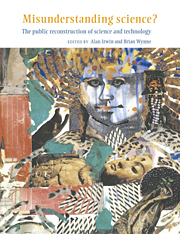Book contents
- Frontmatter
- Contents
- Acknowledgements
- Introduction
- 1 Misunderstood misunderstandings: social identities and public uptake of science
- 2 Science and Hell's kitchen: the local understanding of hazard issues
- 3 Disembodied knowledge? Making sense of medical science
- 4 Now you see it, now you don't: mediating science and managing uncertainty in reproductive medicine
- 5 Ignoring science: discourses of ignorance in the public understanding of science
- 6 Insiders and outsiders: identifying experts on home ground
- 7 Authorising science: public understanding of science in museums
- 8 Nature's advocates: putting science to work in environmental organisations
- 9 Proteins, plants, and currents: rediscovering science in Britain
- Conclusions
- Notes on contributors
- Select bibliography
- Index
4 - Now you see it, now you don't: mediating science and managing uncertainty in reproductive medicine
Published online by Cambridge University Press: 16 October 2009
- Frontmatter
- Contents
- Acknowledgements
- Introduction
- 1 Misunderstood misunderstandings: social identities and public uptake of science
- 2 Science and Hell's kitchen: the local understanding of hazard issues
- 3 Disembodied knowledge? Making sense of medical science
- 4 Now you see it, now you don't: mediating science and managing uncertainty in reproductive medicine
- 5 Ignoring science: discourses of ignorance in the public understanding of science
- 6 Insiders and outsiders: identifying experts on home ground
- 7 Authorising science: public understanding of science in museums
- 8 Nature's advocates: putting science to work in environmental organisations
- 9 Proteins, plants, and currents: rediscovering science in Britain
- Conclusions
- Notes on contributors
- Select bibliography
- Index
Summary
Visual imagery is often presented as capturing ‘literal reality’, especially in a climate of increasing surveillance. The quest to better ‘the view’ has spurred the development of technologies that enhance visibility and provide useful images. Telescopes, microscopes, X–rays, and then ultrasound and other scanning devices have opened up wholly new areas of observation. They have also fostered new alliances, evaluation criteria and agendas – new routes to authority and of entry into the politics of representational practices. Surveillance, for instance, particularly since Foucault (1979), has become a way of asserting the political character of visualisation. However, this analysis may deflect attention away from imaging practices premised on a ‘mutuality of knowing’, and on ‘care’ as well as ‘control’ (Lyon 1993). Moreover, central issues of power and accountability also arise when there is a shift of domain, as the image is transferred beyond the legitimate realm of the ‘expert’.
Images invite action: the use of technologies of visual depiction are now central to medical interventions. In general, diagnostic images are intended, above all, for expert scrutiny: elaborate conventions exist to shield such images from public display. Captured on plate, film, or tape, these images are scanned for signs of pathology and become substitutes, surrogates for the subject under clinical observation: as authorised depictions, they are also readily available for evaluation, in group discussion in the clinic, or in a court of law in a malpractice suit. Patients can be elsewhere: their physical presence is no longer required. The images become constituted as technical data, and such technical data can come to be seen as determining the diagnosis.
- Type
- Chapter
- Information
- Misunderstanding Science?The Public Reconstruction of Science and Technology, pp. 84 - 106Publisher: Cambridge University PressPrint publication year: 1996
- 2
- Cited by

